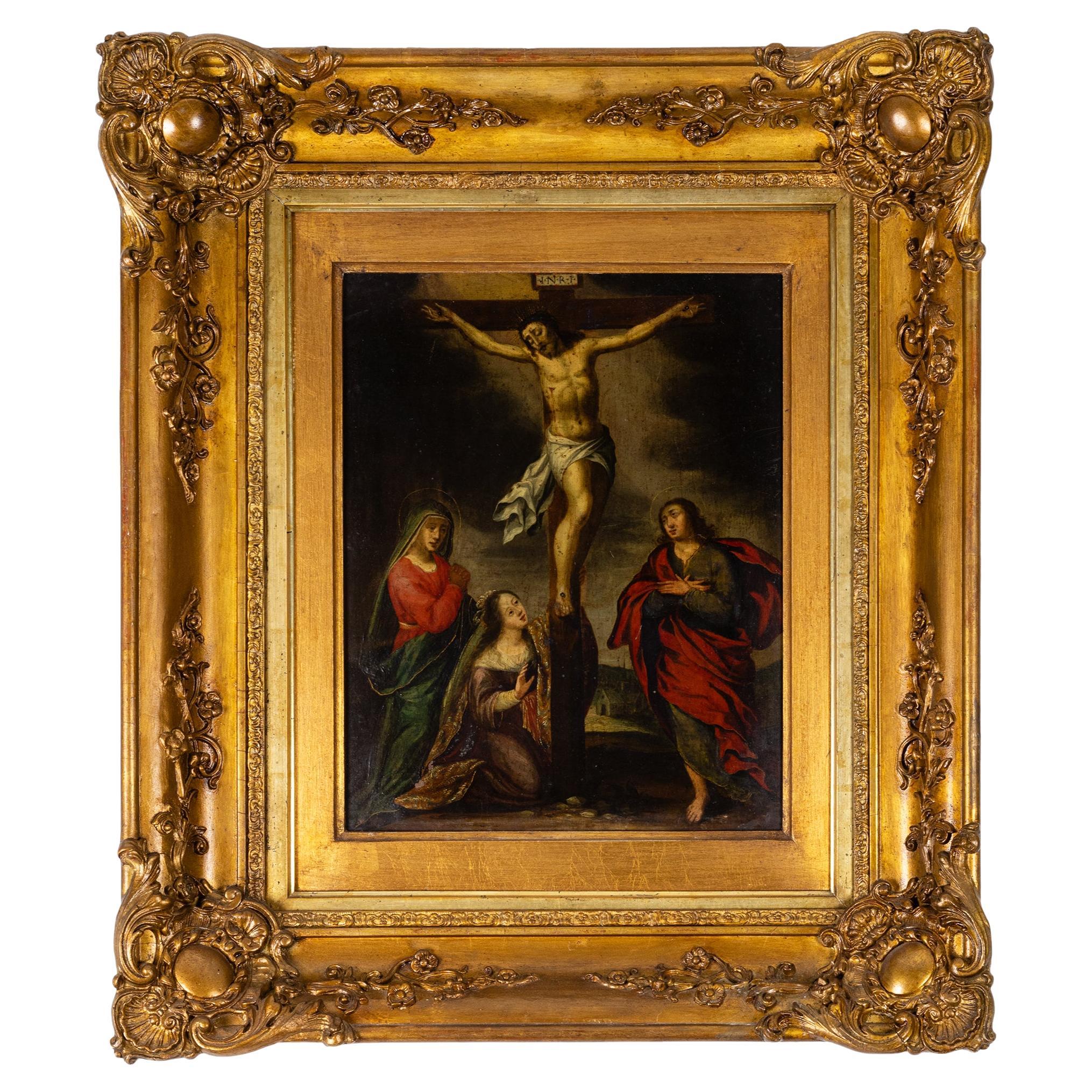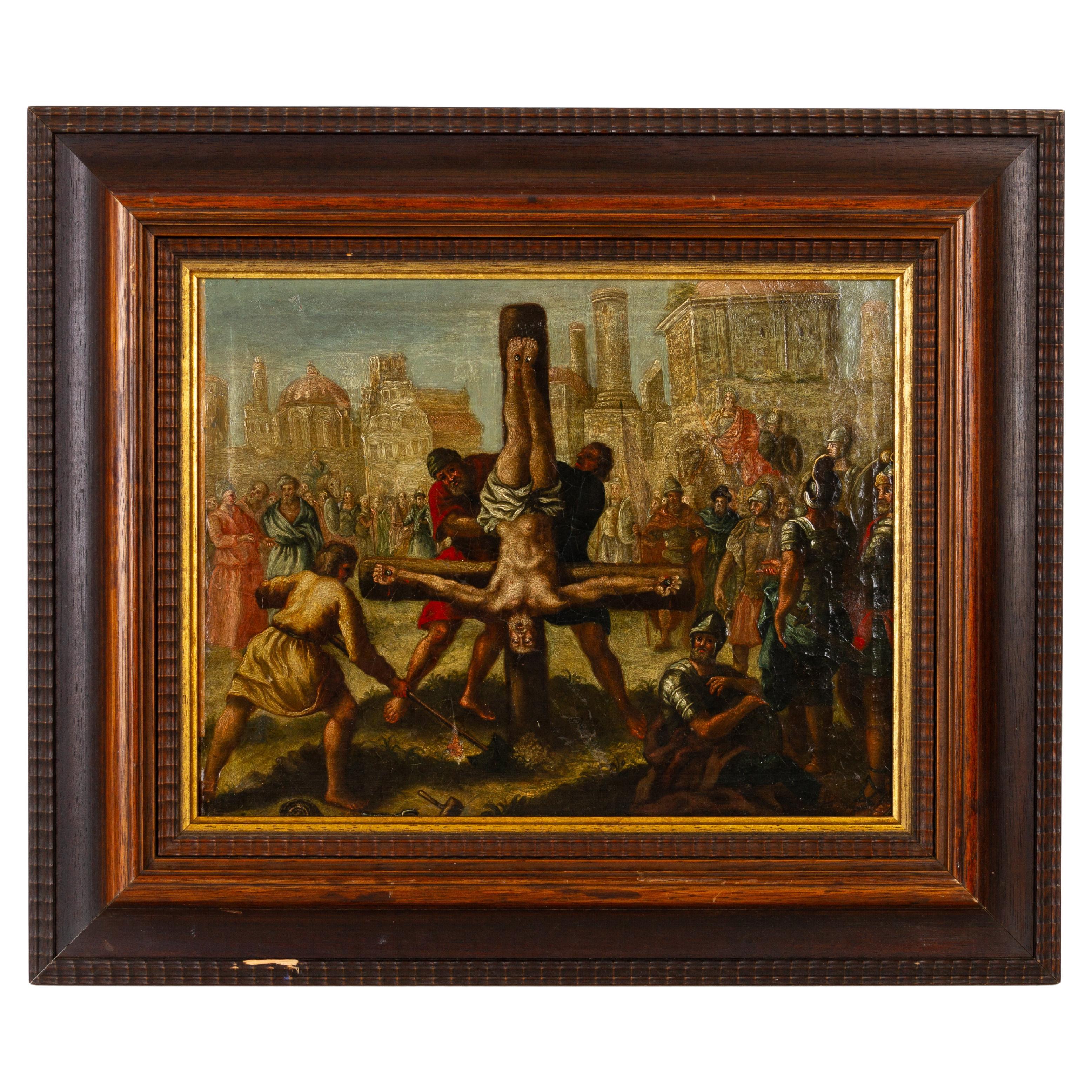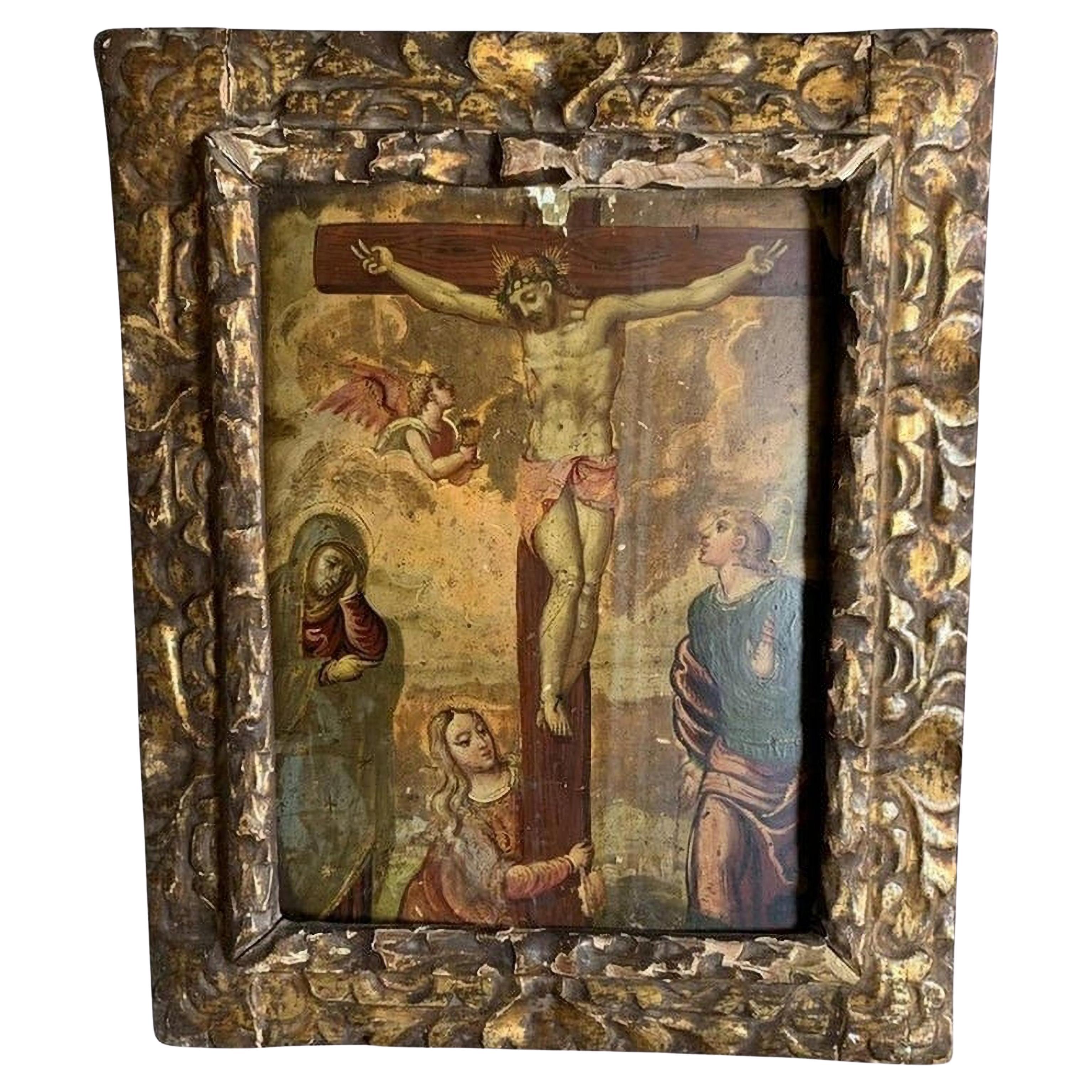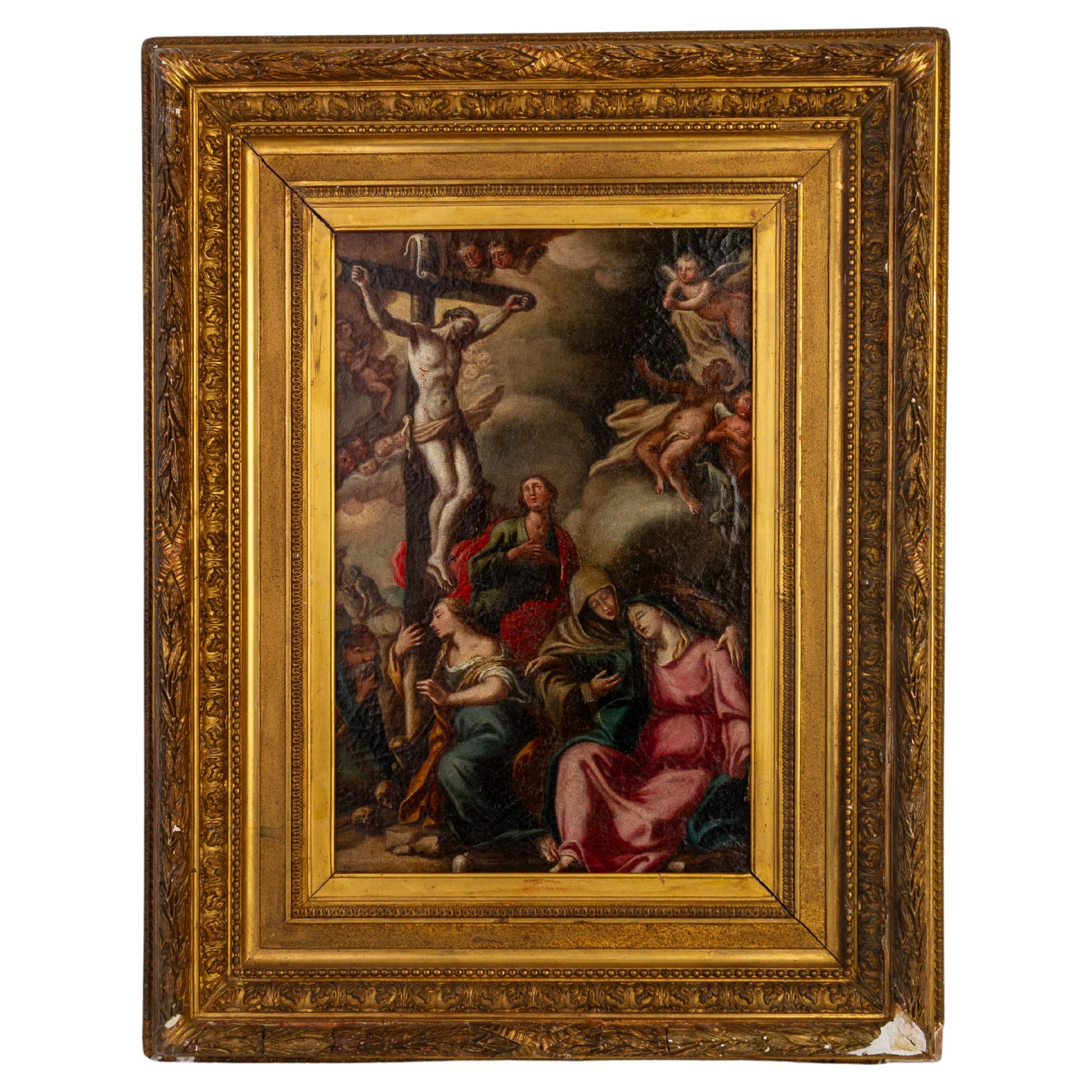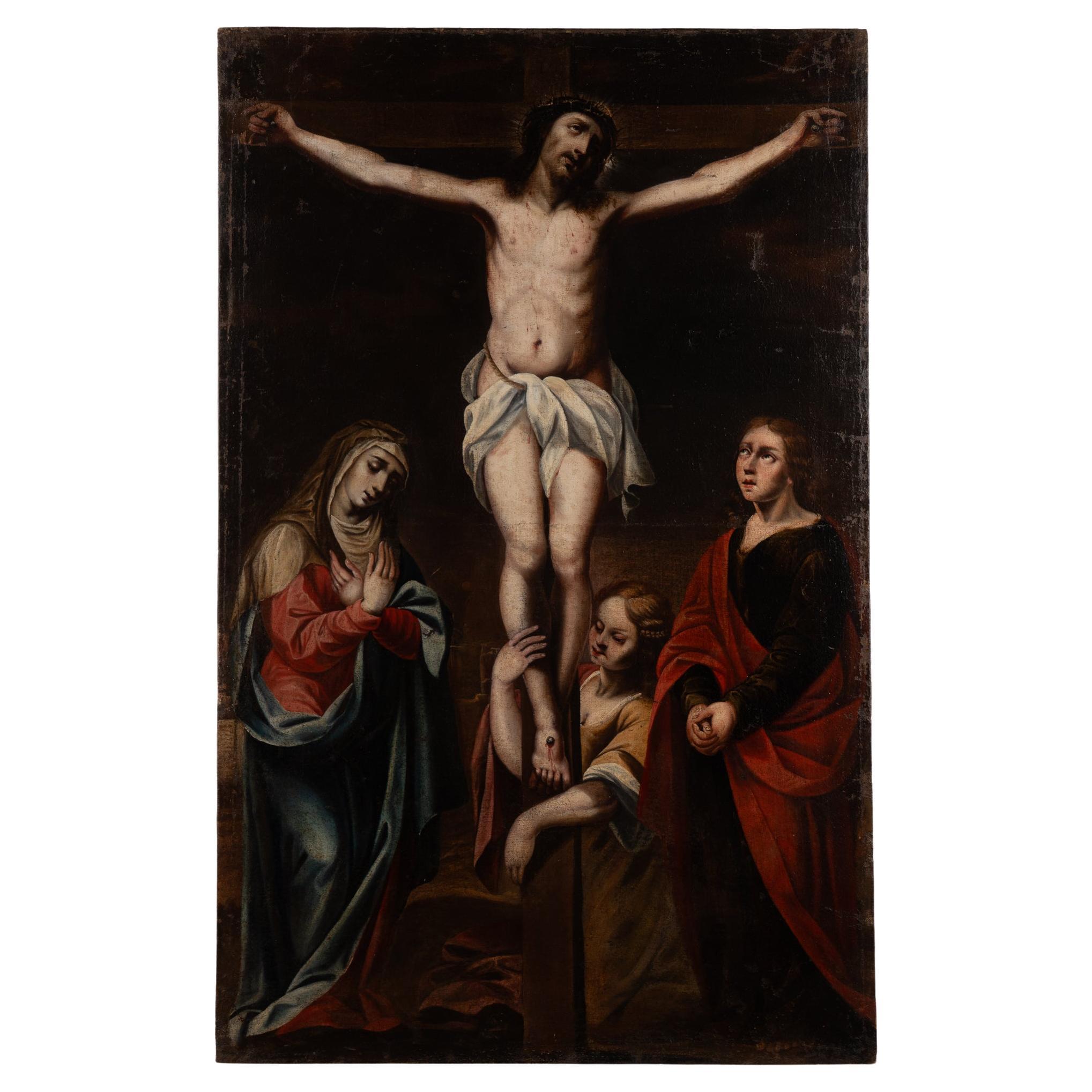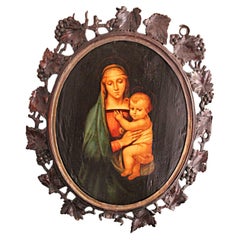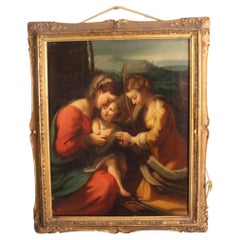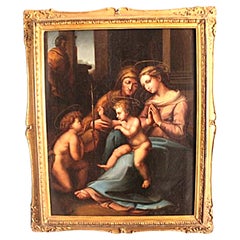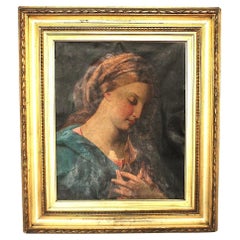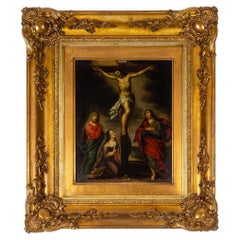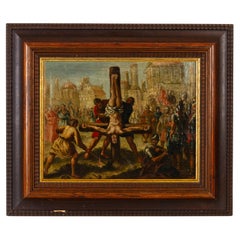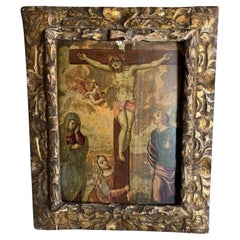Items Similar to 17th Century Italian Crucifixion Painting – Oil on Panel, Baroque Devotional Art
Video Loading
Want more images or videos?
Request additional images or videos from the seller
1 of 21
17th Century Italian Crucifixion Painting – Oil on Panel, Baroque Devotional Art
$5,132.98
$6,416.2220% Off
£3,720
£4,65020% Off
€4,372.52
€5,465.6520% Off
CA$6,981.20
CA$8,726.5120% Off
A$7,822.40
A$9,77820% Off
CHF 4,071.86
CHF 5,089.8220% Off
MX$95,695.05
MX$119,618.8220% Off
NOK 51,684.70
NOK 64,605.8720% Off
SEK 48,815.58
SEK 61,019.4820% Off
DKK 32,641.74
DKK 40,802.1720% Off
Shipping
Retrieving quote...The 1stDibs Promise:
Authenticity Guarantee,
Money-Back Guarantee,
24-Hour Cancellation
About the Item
17th Century Italian School Crucifixion Oil on Panel
This exquisite 17th-century Italian School Crucifixion oil painting is a masterpiece of Baroque religious art, showcasing profound theological depth and artistic excellence. Created with oil on panel, the work embodies the dramatic interplay of light and shadow, a hallmark of the Italian Baroque Crucifixion artwork style.
At the centre of the composition is Christ on the Cross, portrayed with striking detail and emotional intensity. The Crucifixion oil painting captures the pathos of Christ’s sacrifice, inviting viewers into a moment of reflection and reverence. The richly detailed religious painting uses vibrant colours and meticulous brushstrokes to highlight the anguish and redemptive significance of the scene.
Flanking Christ are representations of the Holy Trinity. God the Father, robed in majesty, radiates divine authority and compassion. His gesture towards the Cross signifies both approval of the redemptive act and the eternal love between Father and Son. Above, the Holy Spirit appears as a dove or luminous figure, rendered with delicate brushwork to evoke a celestial and tranquil presence.
Attributes of the Painting
Medium: Antique oil on panel artwork.
Period: 17th century.
Style: Baroque Christian iconography, reflective of the Italian School Oil on Panel tradition.
Condition: Expertly cleaned and restored with some overpaint in the landscape.
This painting demonstrates the timeless beauty and devotion characteristic of Italian religious art from the 1600s. The masterful use of light and shadow, combined with the symbolic richness of the composition, makes it an extraordinary example of historic Christian art from Italy.
Provenance and Unique Features
This remarkable piece originates from the Della Faille de Leverghem collection, a testament to its historical significance. The old master painting’s crucifixion theme is further authenticated by numerous wax seals on the reverse. With dimensions of 63 cm by 60 cm, this panel is perfectly sized for display in a collection of collectable Italian religious paintings.
Why Choose This Painting?
Iconic Representation of the Crucifixion: A blend of emotional gravitas and spiritual symbolism.
Historical Significance: A valuable addition for collectors of Old Master paintings and Baroque period art enthusiasts.
Meticulous Restoration: Ensures longevity while preserving the original artistry.
Investment Potential: The value of Italian Baroque Crucifixion artwork continues to appreciate, making it a wise choice for collectors.
A Testament to Italian Baroque Religious Art
This 17th-century devotional art is a treasure for religious art enthusiasts and interior designers sourcing antique oil on panel artworks. Its blend of masterpieces of Italian School design with symbolism in 17th-century crucifixion art ensures it stands as a timeless statement of faith and artistry.
Whether you’re drawn to its spiritual resonance or its artistic mastery, this 17th-century Italian School Crucifixion Oil on Panel is a standout piece for any collection.
Possibly a study for a much larger painting.
- Dimensions:Height: 25 in (63.5 cm)Width: 25 in (63.5 cm)Depth: 2 in (5.08 cm)
- Style:Baroque (Of the Period)
- Materials and Techniques:
- Place of Origin:
- Period:
- Date of Manufacture:circa 1680
- Condition:Repaired: Some minor paint retouching. The painting has recently been cleaned. Refinished.
- Seller Location:Seaford, GB
- Reference Number:1stDibs: LU10376244239672
About the Seller
New to 1stDibs
Joined in the past six months.
No Reviews Yet
Vetted Professional Seller
Every seller passes strict standards for authenticity and reliability
Established in 2021
1stDibs seller since 2025
Typical response time: 1 hour
- ShippingRetrieving quote...Shipping from: Seaford, United Kingdom
- Return Policy
Authenticity Guarantee
In the unlikely event there’s an issue with an item’s authenticity, contact us within 1 year for a full refund. DetailsMoney-Back Guarantee
If your item is not as described, is damaged in transit, or does not arrive, contact us within 7 days for a full refund. Details24-Hour Cancellation
You have a 24-hour grace period in which to reconsider your purchase, with no questions asked.Vetted Professional Sellers
Our world-class sellers must adhere to strict standards for service and quality, maintaining the integrity of our listings.Price-Match Guarantee
If you find that a seller listed the same item for a lower price elsewhere, we’ll match it.Trusted Global Delivery
Our best-in-class carrier network provides specialized shipping options worldwide, including custom delivery.More From This Seller
View All19th century After Rahael Grand Duke’s Madonna Painting
By (after) Raphael (Raffaello Sanzio da Urbino)
Located in Seaford, GB
After Raphael's Grand Duke's Madonna
Grand Duke's Madonna after Raphael, a stunning 19th-century oil painting from the renowned Berkley Collection. This remarkable artwork, inspire...
Category
Antique Late 19th Century Italian Renaissance Paintings
Materials
Paint, Paper
$1,828 Sale Price
20% Off
18th century Antonio Correggio The Mystic Marriage of St Catherine
By Antonio da Correggio
Located in Seaford, GB
Antonio Correggio’s The Mystic Marriage of St. Catherine
This stunning 18th-century copy draws inspiration from the masterpiece The Mystic Marriage of Saint Catherine, originally pa...
Category
Antique Mid-19th Century Italian Renaissance Paintings
Materials
Canvas
$2,437 Sale Price
20% Off
After Raphael The Madonna Of Divine Love oil on canvas
By (after) Raphael (Raffaello Sanzio da Urbino)
Located in Seaford, GB
Early 19th-Century Italian School Oil on Canvas – After Raphael
The Holy Family with Saint Elisabeth and the Infant Saint John the Baptist
Introduction: A Masterpiece Inspired by Rap...
Category
Antique Early 19th Century Italian Renaissance Paintings
Materials
Canvas
Studio of Pompeo Batoni, “Madonna of the Annunciation– Mid-18th Century Italian
Located in Seaford, GB
Country HouseAn exceptional mid-18th-century oil painting from the Studio of Pompeo Batoni (1708–1787), presenting a revered composition: The Madonna of the Annunciation. This rema...
Category
Antique Mid-17th Century Italian Grand Tour Paintings
Materials
Canvas
Flemish 16th century Madonna in a Rose Garden
Located in Seaford, GB
The Madonna and Child Oil Painting in a Rose Garden – Flemish (Ambrosius Benson School)
Late 16th Century/ Early 17th Century Flemish Oil Painting on Oak Panel
Artist & Background
This exquisite Flemish Renaissance Madonna and Child oil painting, titled Madonna and Child in a Rose Garden, is attributed to a follower of Ambrosius Benson (circa late 16th - early 17th century). Benson, originally from Lombardy, Italy, became a renowned master painter in Bruges, Flanders, in the early 1500s..
Key Features of This Madonna and Child Painting:
Period & Style – Late 16th-century Flemish School, influenced by Gerard David and Leonardo da Vinci.
Medium – Oil on oak panel, a signature technique of Flemish masters.
Composition – The Virgin Mary and Christ Child are set in a serene rose garden, symbolising purity and divine love.
Influence – This artwork reflects both Netherlandish precision and Lombard artistic traditions.
Provenance & Demand: Benson’s followers were widely sought after, and his compositions commanded high market value among collectors.
Antique Hand-Carved Frame Old Master Madonna and Child Artwork
This painting is housed in an original 17th-century hand-carved wooden frame featuring a classic egg-and-dart motif.
Condition Report
Conservation Status: Professionally cleaned.
Historical Cracking: Some age-related panel cracks are common in antique oil paintings.
Restoration: Minor retouching to the Madonna’s face, enhancing original details.
Why Invest in Flemish Renaissance Art?
Historical Significance – Works by Ambrosius Benson’s followers remain highly collectable in the art market.
Museum-Quality Piece – Suitable for private collectors, investors, and art connoisseurs.
European Heritage – A fine example of an Old Master religious painting...
Category
Antique 1610s Belgian Renaissance Paintings
Materials
Oak, Paint
Antique Venetian capriccio oil painting
Located in Seaford, GB
Francesco Guardi Venice Oil Painting – Venetian Art in the Manner of Guardi
Exquisite 19th-Century Venetian Oil Painting
Experience the timeless elegance of Venetian art with this r...
Category
Early 20th Century Paintings
Materials
Pine, Paint
$1,717 Sale Price
20% Off
You May Also Like
Baroque Crucifixion Of Christ, Religious Painting, Oil On Copper, 17th Century
Located in Lisbon, PT
This 17th century Italian Baroque painting, executed in oil on copper, depicts the Crucifixion of Christ with remarkable depth and dramatic composition.
Christ is shown on the cross...
Category
Antique 17th Century Italian Baroque Paintings
Materials
Copper
$8,444 Sale Price
20% Off
Hispano-Portuguese 19th Century Oil Painting on Board, Icon "The Crucifixion"
Located in Los Angeles, CA
An Hispano-Portuguese 19th century oil on board depiction of "The Crucifixion". The baroque icon style painting depicting the Crucifixion of Jesus Christ outside the city walls of Jerusalem, north of Mount Zion...
Category
Antique 19th Century Spanish Baroque Revival Paintings
Materials
Wood
$9,450 Sale Price
36% Off
17th Century Old Master Oil Painting Crucifixion of St Peter
Located in Nottingham, GB
In good condition
From a private collection
Free international shipping
17th Century Old Master Oil Painting Crucifixion of St Pe...
Category
Antique 17th Century Paintings
Materials
Canvas, Paint
Italian School Table of the 16th Century "Crucified Christ with the Virgin"
Located in Madrid, ES
Italian school table of the 16th century
"Crucified Christ with the Virgin, Saint John and Mary Magdalene"
Oil on board
Period frame 16th century ( gold frame parts )
Measures: 41cm ...
Category
Antique 16th Century Italian Baroque Paintings
Materials
Paint
17th Century Old Master Crucifixion of Christ
Located in Nottingham, GB
In good condition
From a private collection
Free international shipping
17th Century Old Master Crucifixion of Christ
Category
Antique 17th Century Paintings
Materials
Canvas, Paint
18th Century Oil on Canvas Painting of Crucifixion of Christ with Mother Mary
Located in Round Top, TX
Large original oil on canvas painting of the crucifixion of Christ hanging on the cross, with his Mother Mary and two other female figures. Unframed, just over 4.5' tall.
Beautifully...
Category
Antique Early 18th Century Spanish Paintings
Materials
Canvas, Wood, Paint
More Ways To Browse
Italian Baroque Art
Italian Religious Icon
Italian Art Antique Painted Religious
God Of Longevity
Holy Spirit Dove
Dutch Bombe Drawers
East Indian Bronze
Egyptian Porphyry
Eight Immortals
English Setter
F J Gallery
Flapper Girl
Flora Cabinet
Folio Table
French Curio Cabinet
French Empire Secretaire
French Shop Counter
George Iii Bureau
